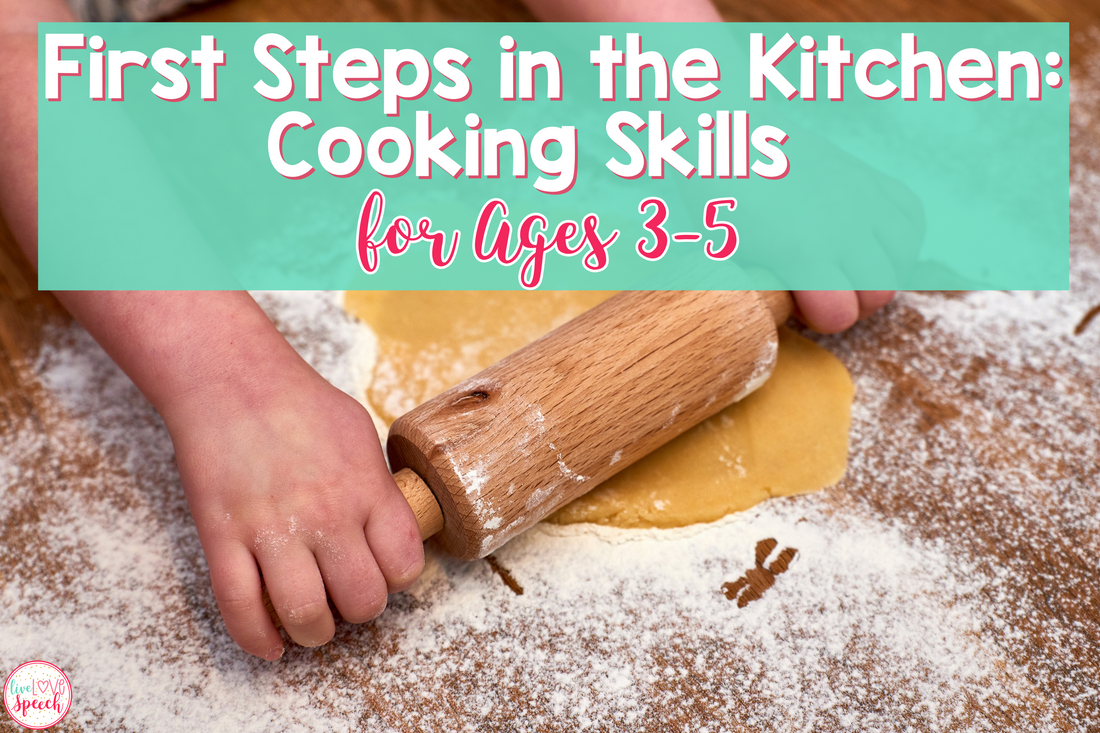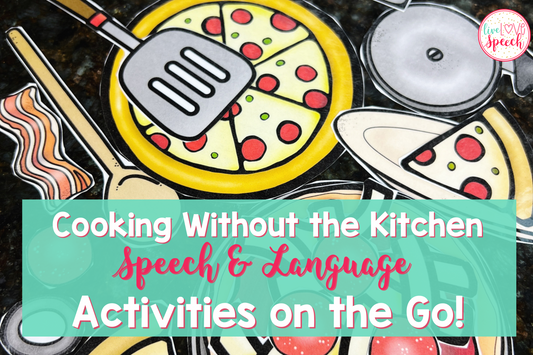
When it comes to beginning your journey cooking with kids, it may not be an easy task. Knowing and understanding what they should be doing and what they are capable of doing, besides just stirring the bowl, is crucial.
As someone who loves to cook and has been cooking with kids for years, I have seen firsthand what skills are needed at each age. Understanding the appropriate cooking skills for each age is important because it ensures the safety of the children, keeps them engaged, and helps build their confidence and interest in cooking.
In this blog post, I want to cover all the basics of what each age should be doing when it comes to cooking skills. Ages 3, 4, and 5 are pivotal for introducing children to the kitchen environment. Not only will I outline what tasks they should be capable of handling, but I'll also provide practical ideas on how to approach these tasks together. Let's start on the First Steps in the kitchen!
WHY YOU SHOULD BE COOKING WITH KIDS

Cooking with kids isn't just about making meals—it's a valuable learning experience with numerous benefits. First, it fosters essential life skills from a young age, teaching them about nutrition, following instructions, and kitchen safety. Second, it encourages creativity and exploration, allowing children to experiment with flavors and textures. Third, cooking together strengthens bonds and creates lasting memories.
You can start cooking with kids as early as age 3, supervising closely and gradually introducing more complex tasks as they grow. Whether at home, in a classroom setting, or as a homeschool activity, cooking offers endless opportunities for education and fun. It's not a daunting task but a rewarding journey that enriches both learning and family time. Looking for more reasons to cook with kids check out my blog post 5 Reasons You Should Be Cooking with Kids.
COOKING SKILLS FOR AGE 3

At age 3, children are eager to explore and learn, making it an ideal time to introduce them to basic cooking skills. Here are some simple tasks they can start with:
Washing Fruits and Vegetables: Begin by teaching them how to rinse fruits and vegetables under running water. Use a small step stool if needed to help them reach the sink safely. Show them the importance of cleanliness in preparing food.
Mixing Ingredients: Show your child how to stir ingredients in a bowl using a large spoon or spatula. Start with simple mixtures like pancake batter or muffin mix. This activity not only teaches them basic mixing techniques but also introduces them to following recipes.
Spreading: Demonstrate how to spread soft spreads like peanut butter, cream cheese, or jam onto bread or crackers using a child-safe spreading knife. Guide their hand gently to ensure even spreading and prevent spills.
Tearing: Encourage your child to tear soft herbs like basil or lettuce into smaller pieces for salads or sandwiches. This helps improve their fine motor skills and introduces them to different textures and flavors.
Pouring: Allow them to practice pouring liquid ingredients (under close supervision) from a small pitcher or measuring cup into a bowl or container. Teach them to pour slowly and steadily to avoid spills.
Approaching These Tasks Together: Cooking together at this age is as much about bonding as it is about teaching skills. Make it a fun and interactive experience by explaining each step and letting them explore textures and tastes. Encourage questions and observations to foster their curiosity about food and cooking.
By introducing these activities gradually and with patience, you'll not only nurture their interest in cooking but also build their confidence in the kitchen.
Cooking Skills Age 4
At age 4, children are ready to take on more involved tasks in the kitchen. Here

are some skills they can begin to master:
Measuring Ingredients: Introduce simple measurements like cups and tablespoons. Let them scoop and level ingredients like flour or sugar using measuring cups and spoons. This teaches them basic math concepts and the importance of accuracy in cooking.
Cracking Eggs: Teach them how to crack eggs into a bowl. Start with one egg at a time and supervise closely to avoid shell fragments in the food. This task helps them develop hand-eye coordination and fine motor skills.
Kneading Dough: Show your child how to knead soft dough for bread, pizza, or cookies. Use a clean surface and encourage them to use their hands to press and fold the dough. Kneading dough enhances their sensory experience and introduces them to the tactile aspect of baking.
Cutting Soft Ingredients: Allow them to use a child-safe knife to cut soft ingredients like bananas, strawberries, or cheese under close supervision. Teach them proper cutting techniques, such as using a claw grip to protect their fingers.
Assembling Ingredients: Guide them in assembling simple dishes like sandwiches, wraps, or fruit salads. Let them choose and layer ingredients to create their own creations. This fosters their creativity and gives them a sense of independence in the kitchen. You could also let them assemble fun food crafts! I have visual recipes that call for assemble such as my Beach Pudding Cups! Kids will be able to create their own beach scene! Plus, you will receive vocabulary and comprehension questions. Learn more here about my Monthly Themed Visual Recipes.
Approaching These Tasks Together: Cooking with a 4-year-old is an opportunity to build their confidence and competence. Provide clear instructions and demonstrate each task before letting them try. Encourage them to ask questions and offer praise for their efforts. Emphasize safety and cleanliness throughout the process.
Cooking Skills Age 5

At age 5, children are ready to tackle more advanced tasks in the kitchen. Here are some skills they can begin to master with additional examples:
Cracking and Beating Eggs: Expand on egg skills by teaching them how to crack eggs and beat them for scrambled eggs or omelets. Show them how to whisk eggs until smooth, teaching them precision and patience in mixing. They can also learn to separate egg whites from yolks for recipes that require it, such as meringues or custards.
Using Basic Kitchen Tools: Introduce them to basic kitchen tools like a hand mixer (under close supervision) for mixing batter or dough. They can also learn to use a whisk for mixing ingredients thoroughly and incorporating air into batters for fluffy pancakes or cakes.
Rolling Dough: Teach your child how to roll out dough for cookies, pie crusts, or pizza. Provide a rolling pin and a clean surface for them to work on. They can also learn to shape dough into simple forms like balls or logs for breadsticks or rolls.
Cutting with Supervision: Allow them to use a child-safe knife to cut soft vegetables like cucumbers or peppers under close supervision. Provide guidance on proper knife techniques and safety measures to prevent accidents. They can also practice slicing soft fruits like bananas or strawberries for salads or desserts.
Following Simple Recipes: Help them follow along with simple recipes, reading instructions together and measuring out ingredients. Start with recipes that have fewer steps and familiar ingredients to build their confidence in following directions and understanding cooking processes. Consider using a visual recipe with illustrations or photos of each step to make cooking more engaging and accessible for them. With my visual recipes, you will get fun and easy recipes that 5-year-olds can make, and a huge variety ranging from:13 recipes are “no-cook” (no appliances needed), 14 recipes require a small appliance (microwave, blender, mixer, etc.) and 21 recipes require a stovetop or oven (can be modified)For more information check out my Visual Recipe Cards Here!
These cooking skills are age-appropriate and can help children develop confidence, independence, and important fine motor skills in the kitchen. Always supervise children closely when they are using knives, heat sources, or other potentially dangerous kitchen tools to ensure their safety and well-being.
Research consistently shows that involving children in cooking activities can have numerous benefits beyond just learning to prepare food. According to a study published in the Journal of Nutrition Education and Behavior, children who participate in cooking at home are more likely to consume healthier foods and have better overall dietary habits.
REMEMBER cooking together can strengthen family bonds and create lasting memories.
SAVE THIS POST
Pin this post on Pinterest to keep these cooking skills handy the next time you are cooking with your kiddos!






